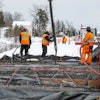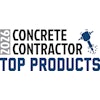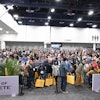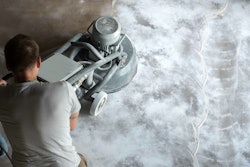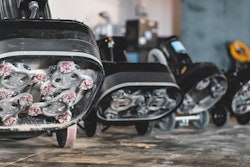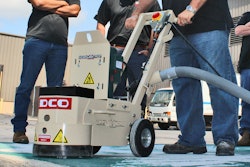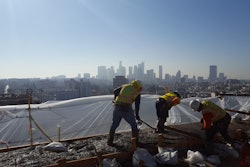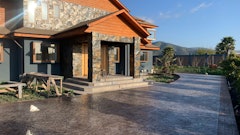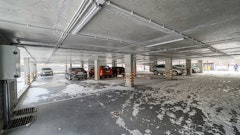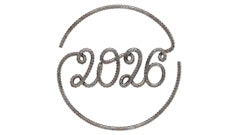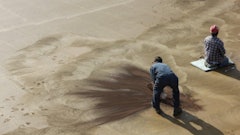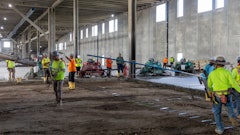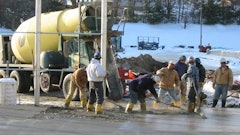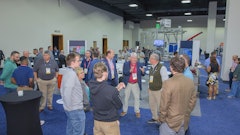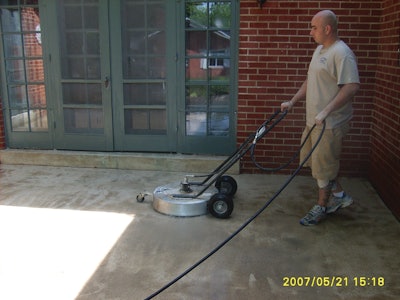
The most essential step to ensure a successful decorative concrete overlay - or any overlay for that matter - is the surface preparation. Surface prep is the key to an overlay's bonding and adhesion.
The most common result of improper surface prep is delamination of the coating. "Delamination is basically where the bond line is broken, and it allows the overlay material to just flake off. It is often misunderstood as material or product failure," says Brian Anderson, director of operations with Concrete Coatings Inc.
Take the proper steps
Before starting any surface prep, the concrete must first be qualified, says Increte Systems' Director of Training Tim Lowe. "Not all concrete is going to be a good candidate for an overlay," he says. The concrete must first be structurally sound and cracks need to be repaired.
Next, identify any possible bond breakers. These could be easily visible like paint stains or a floor covering or invisible like a cure and seal or grease spots. "If there is sealer or paint or whatever that's going to prevent the makeup of the overlay from getting to what it needs to get to it's not going to bond," says John Reynolds, director of training with Solomon Colors/Brickform.
Lowe suggests using a water test to check for invisible bond breakers. Pour a little water onto the surface, and if it beads up or sits on top of the concrete there is something there that will prevent the overlay from bonding.
Bond breakers can either be removed through mechanical or chemical means, Lowe says. The method used will depend on what you are removing and what type of profile is needed. Using a chemical on the concrete will strip off the bond breaker without profiling the surface. Lowe suggests using an acid etch as well to profile and create a more porous substrate for the overlay. If chemical etching is used to remove impurities, all acids should be removed and the concrete neutralized before applying the overlay.
Mechanical methods include grinding, sanding, shotblasting and scarifying. This may be the method of choice if you need a heavier profile or when working indoors where chemicals may cause issues.
Handheld grinders can be used to remove impurity spots, Anderson says. "When in doubt, grind it," he suggests. But use some finesse. Be careful not to over grind or dig deep gouges with the grinder. This will result in an uneven floor.
Mechanical surface prep methods and repair will create dust so properly clean the surface and the work site before beginning the profiling step.
If a concrete surface only has bond breakers in spots - not covering the entire slab - a degreaser may be used. But Lowe suggests degreasing the entire concrete slab just in case there are spots that were overlooked.
Before profiling, determine the type of concrete surface needed for the overlay to adhere. This is dependent on the overlay material and the depth of material being applied. For example, epoxies typically require a more aggressively profiled floor than some other overlay materials, Anderson explains.
How aggressively the concrete surface needs to be profiled will also influence the equipment needed for the profiling. Reynolds suggests purchasing hand grinders, pressure washers and maybe a walk-behind grinder. If a contractor applies a lot of overlays indoors, he may want to invest in a vacuum system as well. But if you have access to equipment rental Reynolds suggests renting some of the larger equipment like shotblasters.
After profiling, properly clean the surface one more time to make sure all the dust and impurities are removed.
Check for moisture
Moisture testing prior to overlay application is essential, Anderson says. Whether on old or new concrete, a vapor transmission test should always be done. A vapor transmission test measures the amount of vapor forced out of the concrete, measured in pounds per thousand square feet. Too much moisture can negatively affect an overlay.
"A typical industry standard is between 3 and 4 pounds per 1,000 square feet. Anything that exceeds that you need to deal with appropriately," Anderson says. "If you're anything above that consult the material manufacturer to find out the best way to handle it." Anderson usually recommends a vapor barrier or vapor dissipating epoxy underneath the overlay.
Contractors also need to test how much moisture is in the concrete. This can be done using either a calcium chloride test or a probe in the concrete, Reynolds says. While the calcium chloride test has been used for moisture testing for years, the newer probe test will measure deeper into the concrete. "There are arguments for both the calcium test and the probe. My feeling is you can never be too safe, and doing both certainly wouldn't hurt. And refer back to the manufacturer's recommendations or specifications as to the maximum amount of what moisture vapor transmission should be for their product to work," Reynolds says.
Rules to live by
Every job is different, and the required surface preparation will vary just as much. If you want to avoid overlay problems and call backs, here are some surface prep rules to live by. Do not cut corners. Do not rush. Do the surface prep how it should be done. Be obsessive. A thorough, complete surface preparation process is the best start to a trouble free adhesion.
And when in doubt, call someone who knows more, Lowe adds. Always ask for help before moving on. Talk to the overlay material manufacturer and find out what surface prep they recommend.


